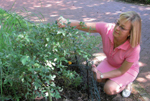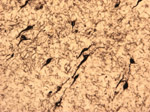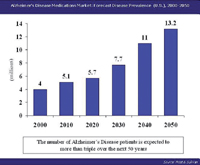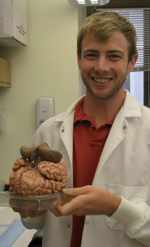|
|
|

|
Harveting youth: Aging Center's goal
|
by Dawn Brazell
Public Relations
Lotta Granholm, Ph.D., DDS, leans down and picks plump blueberries off
the bushes in her yard. She offers up a handful, practicing what she
preaches as director of MUSC’s Center on Aging.
 Dr. Lotta
Granholm picks blueberries from a bush in her yard. The director
of MUSC’s Center on Aging encourages healthy lifestyle habits to
promote brain health. Dr. Lotta
Granholm picks blueberries from a bush in her yard. The director
of MUSC’s Center on Aging encourages healthy lifestyle habits to
promote brain health.
The neurosciences professor knows from her research at MUSC what a
potent protector this fruit can be in keeping brains healthier and
dementia-free. It’s convincing enough that she has the bushes growing
in her yard, and she’s out beating the bushes hoping more people will
hear about the advances in aging research and use the Center on Aging’s
growing resources.
The center has ambitious plans, but it needs to, said Granholm.
 The
center supports aging research, such as studying neurofibrillary
tangles, pictured to the left, that form in the brain of people with
Alzheimer’s disease. The
center supports aging research, such as studying neurofibrillary
tangles, pictured to the left, that form in the brain of people with
Alzheimer’s disease.
“The loftiest goal we have is to actually improve longevity in South
Carolina. The average lifespan here is lower than most other states,
and about five years lower than the national average.”
The nation’s aging demographics prove the need for action. The baby
boomers are hitting their 60s, and it has been calculated that 10,000
people will turn 60 every day for the next 20 years. Because of an
increased lifespan, the population of those more than 85 years will
increase fivefold in that same period, she said.
Compounding the problem is that fewer than .5 percent of health
professionals are trained in geriatrics, despite that 40 percent of
doctor’s visits are for elderly people.
The center, which is the oldest research organization at the
university, hopes to change that and position the university and state
to better handle an aging population. One method is to increase the
volume and quality of research concerning aging with the center serving
as a clearinghouse for the scientists, health professionals,
private-sector partners and the public who want easy access to the
latest resources on aging, she said.
Another method is to promote the close interaction within MUSC of the
various specialty areas involved with aging from MUSC’s Movement
Disorders Program and its Alzheimer’s Research and Clinical Programs to
the newly-funded Aging Q3 in the Department of Medicine, a residency
training program aimed at improving physicians’ care of the elderly.
The center truly spans across all colleges, focusing on service,
education and research, she said. “We feel a big mission in terms of
connecting different researchers across campus. So if anyone is
interested in finding research about stroke or macular degeneration or
anything related to aging, they can come to us.”
The center also can assist with research funding. For example, it
recently helped secure a pilot grant for a Parkinson’s disease study.
“With just one year of funding from the Center on Aging, researchers
were able to find six drugs that have potential that we will now
pursue. With a small template of money, we are able sometimes to make a
big difference.”
Community
outreach
To address the complex and seemingly overwhelming health needs of the
elderly, the center is collaborating with other agencies, including the
state’s Office on Aging, S.C. Aging in Place Coalition, the South
Carolina Aging Research Network (SCARN) and the University of South
Carolina’s SeniorSMART program that promotes research and technology to
help the elderly maintain their independence and cognitive skills.
Granholm said MUSC is a partner in the SeniorSMART program with its
SeniorHOME and SeniorBRAIN divisions representing an exciting area of
growth.
“It will get devices out to people, and maybe the state will be able to
provide funding for those who can’t afford it,” she said, explaining a
movement sensor device being developed that can detect when an elderly
person has fallen at home. “Falls are a huge factor as far as quality
of life. Just being able to have that device in their house allows
seniors the ability to live independently and gives loved ones peace of
mind.”
Another important goal is to educate medical students about the
differing needs of elderly patients. The center brought the Senior
Mentor Program to MUSC in 2005 to better prepare MUSC medical students
to meet the needs of an aging population. The program pairs two medical
students to a senior mentor volunteer in the community aged 65 or
older, with the students working with their mentor the entire four
years of their medical school training.
Rebekah Hardin, education coordinator, said that the program is one way
to better educate medical students to be more sensitive to the needs of
elderly people. It allows students to understand on a personal level
how it’s not easy for everyone to pay for aging, Hardin said.
“You can see such a bond created through the four years. We’ve gotten a
great response from students about how it’s helped them see the
stereotypes they have about seniors.”
Not only does the program improve the quality of elderly care the
students will be able to offer, it also sparks an interest in
geriatrics as a specialty for some of them, said Hardin. The
program is being expanded across other colleges, with pharmacy being
added this fall, an exciting addition given the problems of
polypharmacy or the use of multiple medicines in the elderly, she said.
Granholm said the mentor program is the perfect platform for her to
raise awareness among students of the latest research they should be
passing along to their patients. As part of the program, she teaches
the students the importance of the simple things they can teach their
patients to improve quality of life. “I tell them, ‘You are the next
generation. You need to teach every patient—every age that comes in
here—you need to prescribe exercise and the low-fat diets.”
Fountain of youth
Though her community talks focus on aging, it’s not unusual to find
Granholm delivering her message to a young audience of school children.
She knows that’s when lifestyle habits start.
The life expectancy for women in the state is decreasing every year,
she said. “It’s primarily eating habits and lack of exercise. It’s
amazing that the life expectancy for women in South Carolina is
decreasing every year, contrary to the developing countries where it is
increasing. That’s shocking to me and disturbing.”
She attributes this to poverty, lower educational levels and unhealthy
eating habits. Studies have shown that early obesity leads to less
healthy aging. Obesity is a risk factor for many conditions, including
Parkinson’s and Alzheimer’s diseases as well as diabetes, stroke,
cancer and cardiovascular disease. Granholm wants people to get the
connection between unhealthy eating and how that can affect their
brains and accelerate aging.
In South Carolina, the average life expectancy is 75.8 compared with
the national average of 78, and South Carolina is ranked 40th in
longevity according to the Centers for Disease Control and Prevention.
 Claudia Umphlet, a
research specialist, assists Dr. Granholm with her research on aging as
she slices brain tissue that will be stained in order to view specific
cellular components. For information on the Center on Aging, visit Claudia Umphlet, a
research specialist, assists Dr. Granholm with her research on aging as
she slices brain tissue that will be stained in order to view specific
cellular components. For information on the Center on Aging, visit
http://www.musc.edu/aging or SeniorSMART at
http://www.sc.edu/coee/seniorsmart/smarthomeendowedchair.html.
One of the focal areas of her research is to study the diets of people
and to relate it to research being done on the brain, particularly now
that MUSC has its own brain bank, the Carroll A. Campbell Jr.
Neuropathology Laboratory.
“Once we can connect and show people ‘here is what happens to your
brain if you eat this diet,’ it’s a powerful message we can go out
with.”
 Granholm said
she’s had threats from fast-food companies and some parents who have
complained that their children refuse to eat fast-food fare after one
of her talks. It’s a complaint she likes, though, because it means the
students have made the connection between bad lifestyle habits and the
diseases of the brain that they can impact. Granholm said
she’s had threats from fast-food companies and some parents who have
complained that their children refuse to eat fast-food fare after one
of her talks. It’s a complaint she likes, though, because it means the
students have made the connection between bad lifestyle habits and the
diseases of the brain that they can impact.
“If you eat more than a few percent of transfats in your diet
regularly, you will double your risk for Alzheimer’s. In contrast, if
you just walk your dog for half an hour three days a week, you will cut
your risk for Alzheimer’s disease in half. This is what I constantly
talk to people about—moderate exercise. It doesn’t have to be a lot.”
Brain
bank
expands
aging
research
Nicholas Gregory is used to getting funny looks when he tells people
his job title.
Explaining that he’s the brain donation coordinator of MUSC’s brain
bank can be a conversation stopper. But not for long.
Gregory is quick to tell them about the Carroll A. Campbell Jr.
Neuropathology Laboratory that just opened December 2009 and to
highlight the important brain tissue research being done—research
that’s a critical component in finding cures for such devastating
conditions as Alzheimer’s, Parkinson’s and stroke.
Lotta Granholm, Ph.D., DDS, director of MUSC’s Center on Aging and
co-director of the Carroll A. Campbell Jr. Neuropathology Laboratory,
said the brain bank represents a big step forward in establishing a
neuropathology core at the university and in advancing research on
aging.
“The research we’ll be able to do with the brain bank—with the human
brains—is really exciting. We now have 13 brains, and we’re partnering
with other departments to get researchers interested in the human
tissue. The more interest that is raised creates more awareness and
leads to more brains donated.”
 Nicholas Gregory
holds a brain used
for resarch at the MUSC’s brain bank, which opened December 2009. The
bank now has 13 brains being used for research. Nicholas Gregory
holds a brain used
for resarch at the MUSC’s brain bank, which opened December 2009. The
bank now has 13 brains being used for research.
Gregory said the brain bank will make it easier for local researchers
to procure tissue without having to navigate the logistics of getting
it from other states. “We can look at the South Carolina population,
which in turn is the same people our doctors and clinicians are dealing
with, which is comparing apples to apples. We can lead research trials
here and come up with novel ideas and solutions for these problems.”
The laboratory does a postmortem diagnoses on the donated brains in
order to give closure to families, but also so the tissue can be
characterized and researchers can get the types of brain tissue they
need.
“The only way to accurately diagnose Alzheimer’s disease as well as
other neurological disorders is through a postmortem diagnosis,” he
said. “Also, the best way to study these diseases is to look at human
tissue, as mouse and rodent models do not accurately mimic the diseases
we see in humans.”
The state having its own brain bank will also help to solve the health
disparity problems that are unique to this state, which has a higher
incidence of Alzheimer’s disease, diabetes and stroke.
“We want to find out why this is. What is unique about our state that
is causing us to have these high rates of these diseases? The state has
a higher African-American population compared to the rest of the
country and this population is known to have a much higher risk of
developing Alzheimer’s disease and diabetes and is at greater risk for
stroke.”
According to the American Heart Association, South Carolina is sixth
highest in stroke related-deaths. In a recent report from the 2010
Alzheimer’s Disease Facts and Figures from the S.C. Alzheimer’s
Association, the state has the fourth highest incidence of deaths due
to Alzheimer’s disease.
Gregory said the brain bank offers an exciting resource to discover
more about the disparities between racial and ethnic groups. It also
allows research to move faster in discovering causes and treatments for
many different kinds of neurological diseases. The bank currently has
brains from people who have had Alzheimer’s and Parkinson’s diseases,
brain tumors and progressive supranuclear palsy.
“People are excited about this and see that it’s a great opportunity
for the state and for MUSC. It truly can do a lot of good here. We
already have a lot of clinical programs set up that we can collaborate
with. I think we can really make some progress.”
Gregory said the organ donation that people designate on their driver’s
license does not cover the brain. Brain donation requires a donor
registration form and also notification of the next-of-kin, who will be
required to sign a postmortem consent form after death. Anyone can
donate, except for people with certain infectious diseases such as AIDS
or Hepatitis.
Because people suffering from neurological disorders often understand
the need for research, the bank receives many of those types of
donations. It also needs “normal” or non-diseased brains, though, that
can be used as controls in studies, he said. The bank has 13 brains,
with it receiving one every other week. The goal is to increase it to
one a week.
Gregory said neuroscience is an exciting field, with the past decade
seeing an exponential growth in research. “As much as we’ve studied,
there’s still a long way to go.”
Having a local brain bank encourages more local people to make
donations, since research shows people are more likely to donate to a
state-supported program, he said.
“It’s a gift of hope and a way people can give back to their community.
Most people have the heart on their driver’s license. They are willing
to donate their organs to potentially save someone’s life. We believe
this is just as important.”
For more information or to print out a donor form, visit
http://academicdepartments.musc.edu/aging/research/Brain%20Bank/Homepage.htm.
Friday, Aug. 13,
2010
|
|
|






 Granholm said
she’s had threats from fast-food companies and some parents who have
complained that their children refuse to eat fast-food fare after one
of her talks. It’s a complaint she likes, though, because it means the
students have made the connection between bad lifestyle habits and the
diseases of the brain that they can impact.
Granholm said
she’s had threats from fast-food companies and some parents who have
complained that their children refuse to eat fast-food fare after one
of her talks. It’s a complaint she likes, though, because it means the
students have made the connection between bad lifestyle habits and the
diseases of the brain that they can impact.